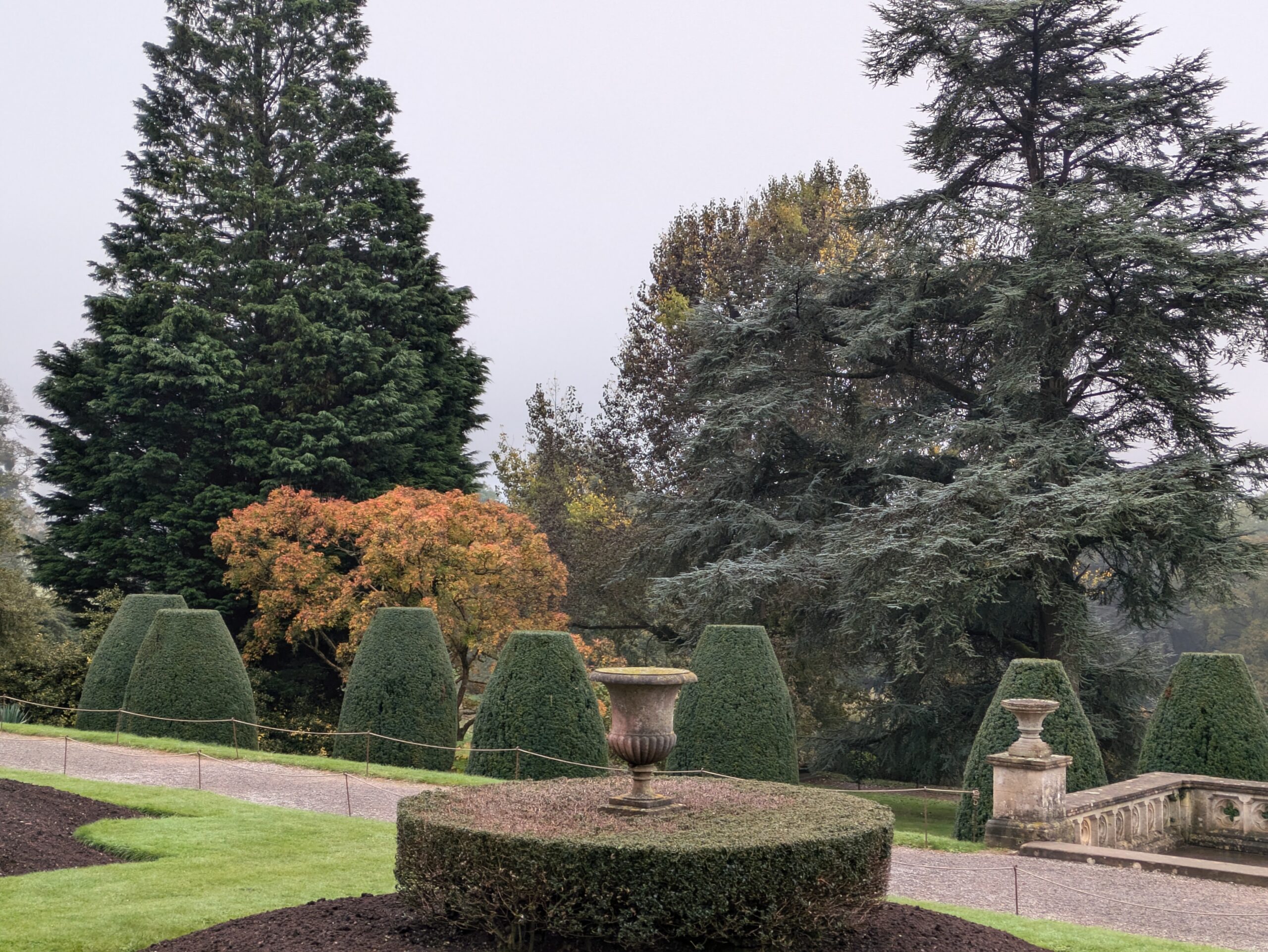
October 2024 saw a group of 24 members visit Somerset to explore 6 gardens / arboreta, one cathedral and two churches – all in 5 days including travel…a very busy trip!
After an uneventful journey we arrived for a restorative soup and a roll before embarking on a visit to Tyntesfield. This is a dramatic country house set in a magnificent parkland with formal gardens close by. The grounds contain a number of national champions, including especially rare holly cultivars, but our self-guided group was particularly interested in tracking down Britain’s largest Japanese Zelkova (Zelkova serrata) – which was certainly impressive and was presenting a beautiful autumnal face for our visit.

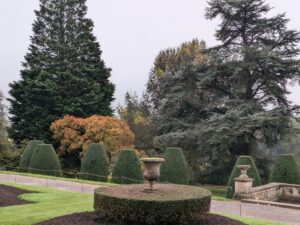
One visit sufficed for the day, and we completed our journey onwards to the hotel near Bridgwater.
The whole of the next day was spent just over the border in Devon at Dunster Castle and watermill. On arrival we wandered gently through the picturesque village to be welcomed by our guide who led us for the best part of the next 2 hours. As the castle, which was owned by the same family for exactly 600 years until donation to the National Trust, is set atop an ancient volcanic mound, the gardens and paths surrounding it are all up and down and the gardens partly slope at 45 degrees…a very real challenge for the grounds management team. One tree that caught the eye, partly because of its exposed position, was a splendid Manna Ash (Fraxinus ornus) Below the slopes there are water gardens and here the walking is easier and the trees are larger, including some very impressive London planes and Giant redwoods.
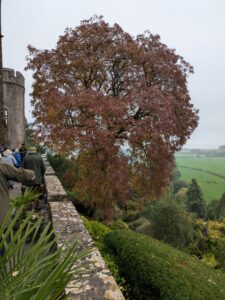
The Watermill café, where we ate lunch, was aptly named as it was situated next to the watermill on the estate which was milling (and selling) flour on the day of our visit.
As a bonus, many of the group also visited Dunster church; an impressive building outside and inside, boasting the longest, and very beautiful, Rood screen in the country. Sadly, as access by coach was not possible, we could not visit nearby Nutcombe Bottom, where we might have seen some of England’s tallest trees – another time, perhaps.
Wednesday’ weather turned out to be the least of the week, but we had a full agenda planned. Before lunch a visit to Montacute, a very elegant but impressive house with grounds boasting some splendid cedar and sweet chestnut trees, as well as any number of fully-grown lime trees that were each dripping with mistletoe!
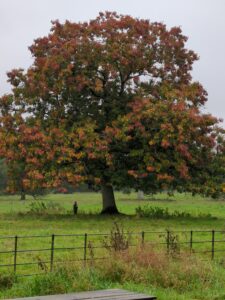

After lunch, which was very nicely set up for us by the staff at Forde Abbey, it was raining hard but we had options: visit the house and stay dry, or persevere outside in the rain. Most of our party chose to do both, prioritising one or the other…. One planned and especially unusual event that afternoon was the meeting with 2 representatives from the Dorset Men of the Trees who joined us after lunch. The conversation whilst wandering, increasingly wet, through the arboretum was interesting for both sides; many shared challenges but also clearly shared charitable purposes and goals – planting more trees. The discussions have suggested potential new approaches for Kent to consider which may allow us to do more work with schools once again. We hope to maintain contact between the two charities for mutual benefit.
Thursday dawned very differently; the sun came out! First stop was Knightshayes, another splendid country estate with very generous parkland beyond a formal garden. Helpfully for us, a “Champion Tree Trail” was mapped and indicated a route to visit these special trees. This was a very enticing option for all the group, who managed to spot the trees listed without too much difficulty. Particularly impressive were the Turkey oak (Quercus cerris) and the Giant redwood (Sequoiadendron giganteum) as well as the girth of the ancient Sweet chestnut trees (Castanea sativa)
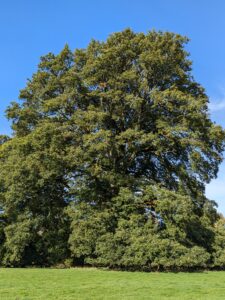

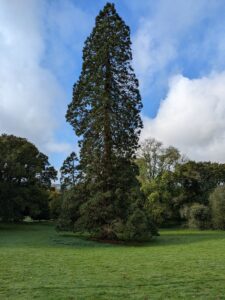
The afternoon visit at Chevithorne Barton was to an arboretum of national importance, which holds the national oak collection. Here our guides generous with their time and walked us around a collection of more than 400 oaks of 220 different species, from all over the world. This was a learning experience for all of us, given the varying shapes and sizes of the trees and of their leaves. Specialist terminology was often used to describe the features of the trees, for example:
- the leaves of oriental / Asian oaks thriving in tropical areas with monsoon rainfall were described as “drippytippy” – meaning the pointy end of the leaf allows water to run off rapidly.
- The oak family was likened to a soup – meaning it was easy to mix up, thus explaining its propensity to hybridise through cross-pollination
What may not be evident to most people is that acorns, unlike many other seeds, cannot be stored long-term in a seedbank, so planting and preserving rare species is vital to ensure these do not go extinct.
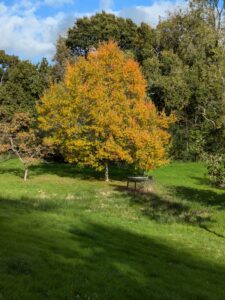

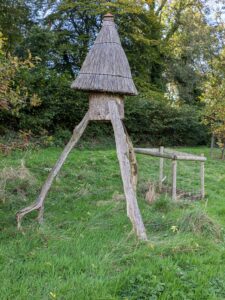
The day ended with a visit to the local parish church, positioned just opposite to our hotel, where yet another impressive rood screen was there to be admired
Our last day, on our way home, gave us time to visit the very beautiful Wells Cathedral, said to be the first cathedral in England to be built in the gothic style. We all enjoyed and learnt from the very informative guides who showed us around – admiring the astronomical clock, the exquisite scissor arches that help support the central tower and the Jesse window of medieval stained glass amongst many other features.
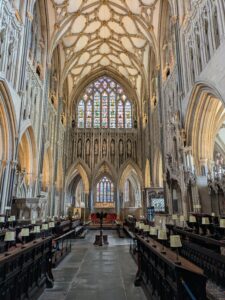
The trip home was, as ever, delayed by congestion on the M25 but this did nothing to spoil the memories from a very successful trip to Somerset.

